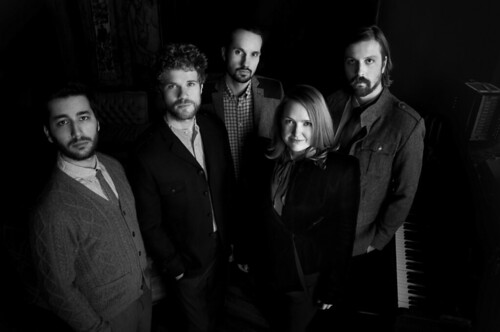
The Wilderness of Manitoba
Midway through the semester, the constant atmosphere of computer screens and concrete can make anyone crazy for some natural scenery. When a patch of grass on Beury Beach just won’t cut it, that’s where The Wilderness of Manitoba comes in. The three-year-old Toronto-based chamber folk band will wrap listeners in haunting harmonies accompanied by guitar or banjo plucks crisper than autumn leaves. Just when one gets nestled into a song, a harmonica, cello or even the roar of a fire can be heard. Noises like footsteps, fire crackling and the hum of an old furnace unintentionally crept its way onto the band’s debut album “When You Left The Fire.” The sounds meld with lyrics painting cozy autumnal scenes such as “Through the auburn streets of leaves, I’m surrounded/ Devils dance amidst the trees to keep me grounded” from the track “November,” making it easy for students to imagine they’ve left the urban jungle.
The Temple News caught up with multi-instrumentalist Scott Bouwmeester to discuss the joys of vinyl, nature and the beautiful unintended consequences of recording in a Toronto basement.
The Temple News: Could you tell me a bit about how and when the band was formed?
Scott Bouwmeester: About three years ago, Will [Whitwham] and I were writing songs that didn’t really have a home. So, we started writing under the moniker The Wilderness of Manitoba and posting songs on the Internet and it sort of grew from there. We ended up getting more members and more people involved and here we are.
TTN: How did you come up with the name?
SB: It comes from an art installation [called “The Wildflowers of Manitoba”] by [Noam Gonick] from Winnipeg up here in Canada. It was interesting because we’ve spoken with the artist and he has said that the installation was inspired by folk music, so for us to be inspired by it, like a folk band to be inspired by it, it’s sort of like this cyclical thing.
TTN: You feature a lot of interesting ambient sounds on a couple of your tracks, such as fire crackling and the hum of a furnace. What inspired you to use those sounds?
SB: We had the intent to record the campfire to use it so we actually built a fire and recorded it, basically. Things like the furnace we couldn’t always control because we would just be in the basement and the furnace would get going in the middle of a track. We have footsteps on there too from people walking upstairs while we were recording.
TTN: So when you went back and listened to it and realized that those sounds were included, what were your thoughts?
SB: I mean they become white noise in a way. I think the mistakes are more virtues to become their own thing.
TTN: Orono Park seems to be a recurring theme throughout a lot of your music. What’s the significance of the park?
SB: Me personally, I grew up in Orono, [Ontario]. It’s a tiny little town about one hour and 20 minutes from Toronto. It was just a nice little park that I grew up in that I had all these great memories from, and [the band] loves the outdoors. I mean anytime we can get to a park or whatever we really appreciate it.
TTN: What story do you feel “When You Left The Fire” tells and why did you produce that album on vinyl?
SB: Well, we really like the idea of the vinyl record. Music in its MP3 phase has become so small and you can have like thousands and thousands of songs on your phone that you can listen to whenever you want to. The idea of a record and actually sitting down and listening to it is like taking a ride while listening. It’s something that we really like when we listen to records and it’s also something that we put a lot of attention to when we’re putting the record together like when we’re ordering tracks and everything. It’s a mood for sure. We recorded in our house last year so there is a lot of intimacy in the record.
TTN: The album also has a theme of the outdoors and nature. Was there a story lyrically that you were trying to tell?
SB: They were really a collection of individual songs that Stefan [Banjevic], [Whitwham] and myself all wrote individual songs. What we found was that we were all dealing generally with the same thing. Different scenes of the outdoors and different scenes of fire and, yeah, that wasn’t planned at all.
TTN: If you could go on tour with any musician, dead or alive, who would it be?
SB: I would love to go on tour with Fleetwood Mac in the ‘70s. I think that would be a crazy party––that would be unreal.
Marisa Steinberg can be reached at marisa.steinberg@temple.edu.



Be the first to comment